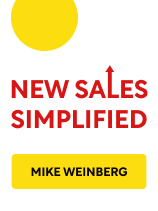

This article is an excerpt from the Shortform book guide to "New Sales Simplified" by Mike Weinberg. Shortform has the world's best summaries and analyses of books you should be reading.
Like this article? Sign up for a free trial here .
Does your company do a lot of face-to-face sales? What is the best way to approach and secure a face-to-face deal?
Getting a face-to-face meeting with a prospect is the culmination of your new business development efforts. There can still be a lot of work to do after the first meeting, including preparing a formal proposal or presentation. But the essential step to winning new business is first getting in front of the prospect and setting the tone for a productive relationship.
In this article, we’ll discuss the eight stages of a face-to-face sales call and what to do at each stage to increase your chances of closing the deal.
Preparing for the Face-to-Face Call
A surprising number of salespeople try to “wing it” in face-to-face sales calls, but the key to a successful call is taking ownership of it from start to finish. You can’t own the call without a plan and structure. Reasons for planning are:
- You’ll come across as a professional.
- It’s the only way to ensure the outcome you want.
In contrast, not planning your call sets you up for two problems:
- Frustrating the customer with a poorly organized call that wastes their time. Since customers are used to poorly handled calls, they’ll treat you like any other sales rep (they’ll try to get rid of you as soon as possible). You’ll have missed the chance to differentiate yourself as someone who offers unique and valuable information.
- Defaulting to the customer’s process. If you don’t have a plan for the meeting and the sales process, the buyer will take charge, and you’ll be less likely to meet your objectives. A customer directing the meeting may start with: “I only have 30 minutes, so what do you have for me?” or they may bombard you with questions that put you on the defensive. In both cases, you don’t get the chance to learn about the buyer’s concerns and ways you can help.
To prepare mentally for the initial face-to-face call, remember that:
- Your purpose is to learn about the prospect’s business to determine how you can address their issues. You should be starting a relationship, gathering information, and opening a dialogue. Listen more than you talk. The initial call isn’t the time to make a presentation.
- You’re on the same side. The sales relationship is sometimes seen as adversarial. However, you should be the buyer’s ally; you’re working with her to solve a problem. Before sitting down for a meeting, look for a way to communicate that you’re on the same side—for instance, by sitting perpendicular to the prospect rather than directly across from her, which is an opposing position.
The Stages of a Sales Call
Conducting a sales call is like piloting an airplane. You must follow a plan with specific stages in the proper sequence. The order is critical to the outcome. Here are the stages of a prospect call:
- Create rapport and learn the customer’s style.
- Introduce the agenda and get buy-in.
- Clear the air (this applies to existing customers).
- Tell the sales story.
- Ask discovery questions.
- Sell.
- Determine fit and explore objections.
- Agree on and schedule the next steps.
1) Create Rapport and Learn the Customer’s Style
At this stage, connect with the customer and make them comfortable. Rather than commenting on a photo on their desk in cliché fashion, have a genuine conversation about news, sports, or something interesting you noticed in their LinkedIn profile. Only chat for as long as the customer wants to—move on if you get one-word answers.
Also, assess the person’s personality and conversational style—for example, are they quiet, talkative, or impatient? As the meeting continues, you’ll want to adapt your approach to the customer—for example, cut to the chase if the customer is impatient. The more comfortable they are with you, the more amenable they’ll be to your ideas.
2) Introduce the Agenda and Get Buy-In
Next, share your agenda, then ask the customer what they’d like to get from the meeting. This accomplishes the following:
- It differentiates you from competitors (most reps don’t have sales call agendas in the first place) and shows that you’re a professional.
- It shows respect for the customer—executives want to know where a meeting is going; sharing the agenda is a professional courtesy.
- It signals that the meeting will be a dialogue, not a typical one-sided presentation the buyer can tune out.
Here’s an example of how Weinberg handles the first two stages: building rapport and sharing the agenda:
- “Thank you for inviting me. Since we set up this meeting for 30 minutes, I’ll make sure we’re done by 10:30. I’ll start with a two-minute introduction to the company and how we help clients, then I’d like to ask a few questions about how you’re dealing with the challenge of late deliveries. Depending on your situation, I can show you some ways we ensure on-time delivery. Then we can discuss whether our services might be a good fit for you and the next step. That’s the agenda I had in mind. What were you hoping to get from this meeting?”
3) Clear the Air
This step applies only to current customers. It’s important to clear up any problems or bad experiences the customer has had with your company before you talk about increasing their business with you.
4) Tell Your Sales Story
In three minutes, tell your client-focused sales story, highlighting why customers turn to you, what you offer, and how you’re different from competitors. Be alert to the prospect’s reactions to the client problems and opportunities you list—for example, a nod or a wince indicates you’ve hit on a relevant issue. If the customer asks a question, answer briefly but don’t go into details and sidetrack your story. Make a note so you can discuss the question further in the next phase of the call.
5) Ask Discovery Questions
In this stage, ask “discovery” questions to gather information, identify problems and opportunities, and demonstrate expertise on issues relevant to the customer. Discovery questions can be personal, strategic, issue-focused, or sales process-focused:
- Personal: Ask questions to discover what’s important to the customer personally—for example, what their goals are, what results they’re seeking, how they’re evaluated, and how you can help them. The more trust and understanding you can build, the more successful the customer relationship will be.
- Strategic: Ask strategic questions to understand the customer’s big picture: about the market, industry, corporate goals and strategies, and internal and external pressures such as cutting costs. Do your research so you can ask specific, relevant questions. Otherwise, your ignorance and laziness will be apparent and make a poor impression.
- Issue-focused questions: After learning about the customer’s environment, ask questions to uncover the specific ways your offerings can help. Convert the client issues highlighted in your sales story (what you’ve done for past clients) into opened-ending probing questions. For example: “How are you handling (X challenge)?” Also, ask about issues the customer reacted to when you told your sales story. Take notes, ask followup questions, and seek clarification. What you learn will help you address the issues in the selling phase.
- Sales process questions: Ask questions about the company’s processes so you can avoid running into internal roadblocks later. For instance, try to determine: who has decision-making authority and who will influence the decision, what the timelines and budget are, what criteria the decision will be based on, and what alternatives to your offer are being considered. You should have the answers to these questions before making a proposal, so you have the best chance at winning the customer’s business.
6) Sell
With the information you’ve gleaned, deliver a sales pitch that incorporates what matters to the prospect. Show that you’ve listened by focusing only on the points relevant to the buyer, and connecting their needs with your offerings using the buyer’s words.
7) Confirm Fit and Explore Objections
This is the time to comment, “From this conversation, it looks like we might be a good fit for your needs. What do you think?” If the customer is slow to confirm you’re a fit, you may need to ask more sales process questions to determine whether there’s an obstacle somewhere. If you have a feeling there’s an issue the client isn’t talking about, ask: “I have a feeling something is concerning you… What are you thinking?”
8) Agree On and Schedule the Next Steps
Simply ask: “What do you propose as a logical next step?” Listen to the response, then summarize the next steps for each of you—for example: “Based on what you’re saying, how about if I do X and you do Y.” Open your calendar and schedule the tasks. Confirm the date and next step one more time.
As you conclude the meeting, don’t go overboard thanking the prospect for their time. Because you’ve delivered value, the prospect should be equally appreciative of the time you spent meeting them.

———End of Preview———
Like what you just read? Read the rest of the world's best book summary and analysis of Mike Weinberg's "New Sales Simplified" at Shortform .
Here's what you'll find in our full New Sales Simplified summary :
- A step-by-step plan for strategically selecting sales targets
- How to develop sales weapons
- How to consistently generate new sales






